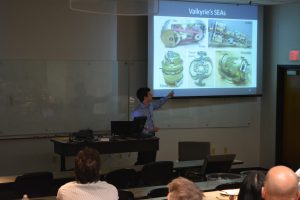Uncategorized
The Valkyrie robot at IHMC taking some steps and doing one legged balance routine. The robot is designed and built by NASA JSC in collaboration with the University of Texas at Austin. Control algorithms by IHMC. Funding for IHMC and UT Austin provided through the NSF/NASA National Robotics Initiative.
Towards Attractor Based Dynamic Stepping
In this video we show improvements on phase-space dynamic walking based on using an absolute return frame and the addition of Coriolis/centrifugal effects. The description of the planner can be found on Arxiv Preprint
IHMC NASA JSC X1 Exoskeleton Powered with UT-SEA Ankles
The Human Centered Robotics laboratory at UT Austin has collaborated with IHMC and NASA to integrate the high performance UT-SEA actuator in the X1 Exoskeleton assistive exoskeleton. The high power to weight ratio of the UT-SEA actuator provides a practical lightweight solution for wearable exoskeletons while fulfilling the demands on delivering high torques needed for walking assistance and rehabilitation.
Full-Body Collision Detection and Reaction with Omnidirectional Mobile Platforms: A Step Towards Safe Human-Robot Interaction
Arxiv Preprint. In the video below, we develop estimation and control methods for quickly reacting to collisions between omnidirectional mobile platforms and their environment. To enable the full-body detection of external forces, we use torque sensors located in the robot’s drivetrain. Using model based techniques we estimate the location, direction, and magnitude of collision forces, and we develop an admittance controller that achieves a low effective mass in reaction to them. For experimental testing, we use a facility containing a calibrated collision dummy and our holonomic mobile platform.
Hume Biped Robot Performing Balance on Split Terrain and Undirected Walking
Arxiv Preprint. The first experiment, shows the Hume biped robot balancing on a high pitch split terrain with and without push disturbances. We implement a Whole-Body Operational Space Controller to compute joint torques consistent with a desired set of operational space accelerations, known contact constraints, and desired internal forces. The internal forces, during multi- contact, correspond to the linear subspace of joint torques that do not cause accelerations of the robot. For undirected walking, Hume continuously steps forward and backward to remain balance. To accomplish this capability, we feed foot trajectories from an algorithm called Continuous Time to Velocity Reversal Online Planner. The planner continuously calculates new trajectories for the feet in an online fashion to recover from disturbances.
Nick Paine Defends his PhD
Luis Sentis Interview on Catalan’s Leading Channel TV3
NASA Valkyrie Mechatronic Development – UT Austin Contributions on Design and Embedded Controls
The Valkyrie humanoid robot was built at NASA Johnson Space Center with leadership from Nic Radford and Rob Ambrose. The Human Centered Robotics Lab at UT Austin provided expertise in the design of rotary series elastic actuators and inspiration for the design of the linear series elastic actuators based on the UT-SEA design of our student Nick Paine. UT Austin also provided expertise on developing robust force controllers of the series elastic actuators and thorough testing on torque tracking and joint position impedance control.
The Legend of the Drunken Robot
This research is sponsored by the US Office of Naval Research. Hume uses its series elastic actuated legs to remain balanced while walking. It achieves this capability by observing the center of mass position error relative to a reference path and re-planning at every step a new reference trajectory to minimize the error. Re-lying on online continous replanning allows the robot to recover from the collisions with the rail stoppers.
First Implementation of Whole-Body Compliant Control with Internal Force Optimization on Hume
This movie shows the first successful implementation of the whole-body compliant controller ( IEEE TRO 2010) on Hume using its series elastic actuators . During the single contact phase, the robot’s hip height and Saggital position, its torso orientation, and the trajectory of the swinging foot are controlled. During the dual contact phase the hip height, torso orientation, and the internal tension between the feet are controlled, instead. In both cases we use floating base dynamic models with contact constraints.


